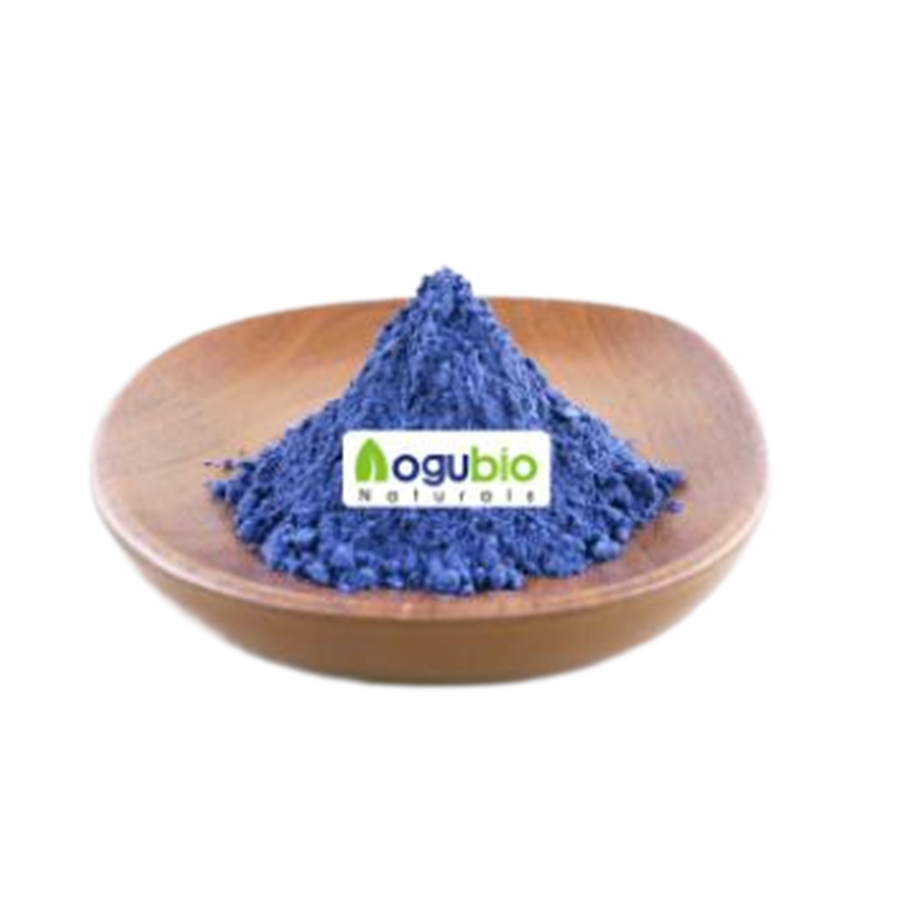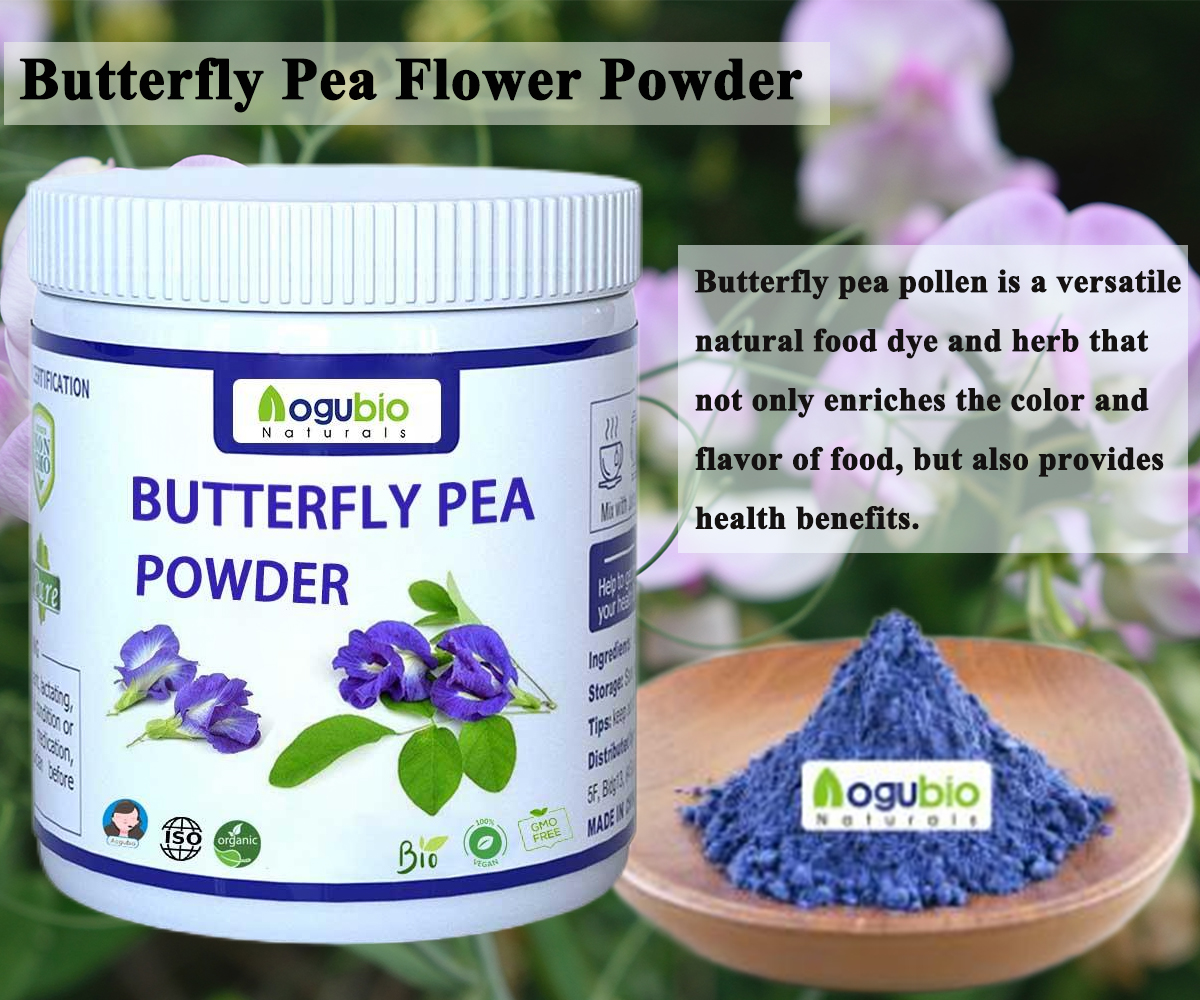
Butterfly pea flower, also known as blue butterfly flower, blue butterfly, butterfly blue flower, butterfly pea, bean bi, butterfly pea, blue pea and Kordofon pea, belongs to Fabaceae and subfamily Faboidae. The origins of the butterfly pea flower are obscure, with some scholars attributing the origin of this legume to tropical America, but its origin is more likely to be Indonesia. The leaves, flowers and young pods of butterfly pea flowers are edible, and the blooming flowers and young leaves can be used to make soup and fry. The sprouts can be used to stir-fry meat or be eaten cooked. Extracts of butterfly pea leaves and flowers can be used as natural food dyes.
Butterfly pea pollen is a powder extracted from the butterfly pea flower plant (scientific name: Clitoria ternatea). Butterfly pea is a creeping plant commonly found in Southeast Asia, South Asia, and South America. It is widely recognized and used for its beautiful blue flowers and its health benefits.
Blue is one of the three primary colors in nature and is the main force in blending various hues. However, it has always been a scarce color among natural pigments, so blue coffee, blue ice cream, blue yogurt, etc. often quickly go out of the circle as soon as they are launched and gain a lot of popularity. Blue has become a popular element that affects market trends. Under the current consumer trend of pursuing naturalness, the FDA has approved butterfly pea flower water extract as a natural blue pigment, which has attracted a lot of attention from domestic and foreign food manufacturers and consumers.
It has "excellent thermal stability and water solubility" and is also photostable. Depending on the pH of the product, it can produce different tones ranging from bright blue, deep purple to natural green. When used in products with a pH higher than 3.8, it can form a "bright denim blue"; when used in products with a low pH, such as sports drinks, it can form a deep purple. In a neutral pH range, its color takes on another hue. In some applications, the pigment is also a pure, transparent bright purple, even better than some synthetic pigments.
Butterfly pea pollen is a powder made from the flowers of butterfly pea flowers. During the production process, the flowers are dried and finely ground into powder. This process preserves the nutritional content and unique color of butterfly pea flowers. Butterfly pea pollen is widely used as a natural food dye and herbal medicine in cooking and beverage making.
- Control blood sugar
A series of in vitro studies on carbohydrases found that Clitoria inhibited intestinal glucosidase (IC 50 of 3.15+/-0.19 mg/ml) and antagonized intestinal sucrase (IC 50 of 4.41+/-0.15 mg/ml) and pancreatic Alpha-amylase (IC 50 4.05+/-0.32 mg/ml). This study provides data from five plant foods evaluating intestinal α-glucosidase and pancreatic α-amylase inhibitory activities and their additive and synergistic interactions. It was concluded that butterfly pea could be used to develop functional foods by combining plant foods for the treatment and prevention of diabetes. Preliminary research also suggests that Clitoria Ternatea is beneficial to the liver and may benefit people with diabetes through its ability to inhibit glucose uptake.
- Regulate endocrine
Butterfly pea flower extract can reduce the starch digestibility and hydrolysis index of flour and predict glycemic index by inhibiting carbohydrate-digesting enzymes. The main compound in butterfly pea flowers, epigallocatechin gallate (EGCG), can promote metabolism, accelerate the energy consumption process, and help lose weight. A study published in the journal "International Obesity and Related Metabolic Disorders" concluded that butterfly pea flower can prevent fatty liver.
- Anti-inflammatory and analgesic
Anthocyanins have a certain antibacterial effect. Researchers have found that anthocyanins extracted from different substances show certain antibacterial effects on different bacteria at different concentrations. In addition, animal experiments have also found that anthocyanins can not only inhibit the growth of bacteria in the body to varying degrees, but also effectively inhibit pro-inflammatory factors in the body, and also have certain anti-inflammatory effects [3]. And butterfly pea flower is an herb traditionally used for arthritis, and its anti-arthritic activity is related to the polyphenols in the petals. For example, quercetin-3 (3-D glucoside supports antibody-mediated TNFa-receptor KTNFR1) in butterfly pea flowers improves arthritis in mice.
- Improve memory
Butterfly pea flowers contain 10 times more anthocyanins than ordinary plants, 8 times that of black wolfberry, and 20 times that of grape seed extract. Unlike other antioxidants, anthocyanins have the ability to cross the blood-brain barrier and directly protect the brain center [3]. One study also showed that the use of 100mg/kg butterfly pea aqueous extract increased acetylcholine in the hippocampus.
- Cool down fever
Butterfly pea is thought to reduce fever (antipyretic) by dilating blood vessels under the skin, thereby increasing blood flow and making it easier to cool down. In one study, the antipyretic potential of methanol extract of butterfly pea flower was evaluated against normothermic and yeast-induced fever in albino rats. Butterfly pea extract significantly reduced normothermic and yeast-induced elevated temperatures in a dose-dependent manner at doses of 200, 300 and 400 mg/kg. The study showed that the antipyretic effect of the extract was comparable to acetaminophen (150 mg/kg body weight), a standard medication for fever.
In cooking, butterfly pea pollen is used in a variety of foods, such as pastries, breads, cookies, ice cream, and desserts. Not only does it give the food a beautiful blue color, it also has a subtle floral aroma. Butterfly pea pollen can also be used to prepare beverages such as tea, juice, cold drinks and wine, adding a special color and taste to the drinks.
Butterfly pea pollen is also widely used in beauty and skin care products. It is thought to promote skin's radiance and elasticity, reduce the formation of wrinkles and dark spots, and fight free radical damage. Therefore, butterfly pea pollen has become an important ingredient in many skin care products and facial masks.
Post time: Oct-31-2023





